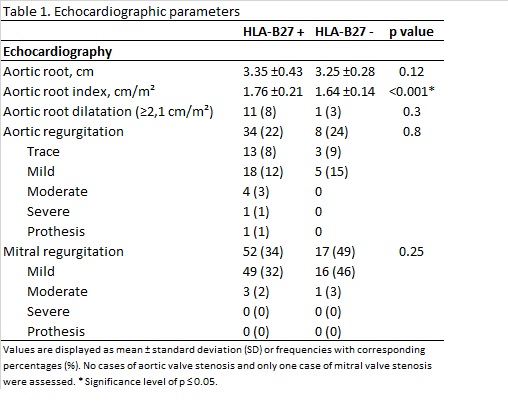Session Information
Date: Sunday, November 8, 2020
Session Type: Poster Session C
Session Time: 9:00AM-11:00AM
Background/Purpose: Ankylosing spondylitis (AS) is an inflammatory joint disease (IJD) associated with cardiac involvement particularly aortic valve regurgitation (AVR). AVR in AS is caused by inflammation of the aortic root and valves. Furthermore, HLA-B27 genotype is strongly associated with AS and with cardiac diseases in non-rheumatic patients. Therefore, the question arises whether HLA-B27 genotype results in an increased risk of developing AVR and aortic root dilatation in AS patients. In this study, we investigated the association between the aortic root diameter in HLA-B27 positive (+) versus HLA-B27 negative (-) patients in AS patients from the CARDAS cohort.
Methods: The CARDAS study is a cross-sectional study in AS patients between 50-75 years who were recruited from a large rheumatology outpatient clinic. Patients underwent cardiovascular screening including echocardiography, with 2D, spectral and colour flow Doppler. The aortic root was measured at sinuses of Valsalva during diastole. The aortic root diameter was corrected for body surface area (BSA) (aortic root index, cm/ m²).
Results: 193 Consecutive AS patients were included of whom 158 (82%) HLA-B27 positive. HLA-B27+ and HLA-B27- AS subjects had a comparable disease duration, respectively 36 (±11) and 30 (±14) years, and a moderate disease activity assessed with the ASDAS-CRP, respectively 2.1 (±1.0) and (2.3 ±1.0). The aortic root index was higher in HLA-B27+ patients compared to HLA-B27- patients, respectively 1.76 ± 0.21 mm vs. 1.64 ± 0.14 mm, p< 0.001. Furthermore, HLA-B27+ AS patients compared to HLA B27- AS patients had more often aortic root dilatation (≥2.1 cm/m²), respectively 11 (8%) and 1 (3%), p=0.3 (table 1). The presence of aortic root dilatation in HLA-B27+ AS patients was strongly associated with aortic valve regurgitation, p=0.003. Regression analysis showed a significant association between HLA-B27 and aortic root index corrected for age, sex and cardiovascular risk factors, B 0.091 (95%CI 0.015-0.168), p=0.02. Furthermore, male HLA-B27+ patients had a significant increased aortic root index compared to male HLA-B27- AS patients, respectively 1.76 (1.63-1.88) and 1.59 (1.53-1.68), p< 0.001.
Conclusion: In conclusion, our study demonstrates an increased aortic root index in elderly HLA-B27+ AS patients, specifically in male patients. Although, this did not result in an increased prevalence of aortic valve regurgitation in this subgroup, inflammation of the aortic root and valve in chronic inflammatory disease is progressive and may progress to severe complications. Therefore, to identify AS patients patient at risk for cardiac disease, we recommend echocardiographic monitoring in elderly male HLA-B27+ AS. Future studies should assess cost effectiveness of cardiologic screening in this subgroup.
To cite this abstract in AMA style:
Baniaamam M, Heslinga S, Handoko M, Konings T, Kamp O, van Halm V, van Denderen J, van der Horst-Bruinsma I, Nurmohamed M. Identifying the as Patient at Risk: Is Aortic Root Diameter Associated with HLA-B27? [abstract]. Arthritis Rheumatol. 2020; 72 (suppl 10). https://acrabstracts.org/abstract/identifying-the-as-patient-at-risk-is-aortic-root-diameter-associated-with-hla-b27/. Accessed .« Back to ACR Convergence 2020
ACR Meeting Abstracts - https://acrabstracts.org/abstract/identifying-the-as-patient-at-risk-is-aortic-root-diameter-associated-with-hla-b27/

